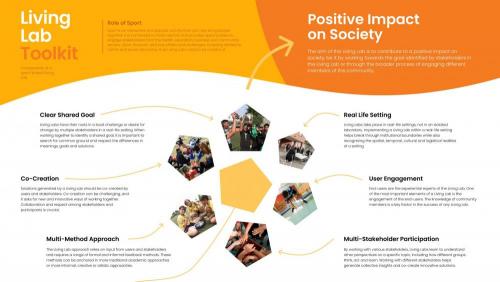
https://www.sportanddev.org/research-learning/guiding-toolkits/co-creati...
Policymakers, researchers and NGOs often emphasise the importance of inclusive, participatory programming. Project participants, local communities and other stakeholders should be involved in the design, implementation, monitoring and evaluation of activities. This will ensure projects meet the needs of their target audience and achieve their objectives.
However, the extent to which this happens is often unclear. Organisations sometimes lack the resources and knowledge to fully understand how to do it in a meaningful and effective way.
One method is by using a Living Lab approach, which is becoming increasingly popular in social science research but is still quite new in sport for development. Following a Living Lab approach, the Sport and Social Cohesion Lab project aims to increase social cohesion in diverse, vulnerable, urban neighbourhoods and support practitioners in delivering high-quality sport for social cohesion programmes. It creates tools and shares knowledge based on the research of project partners, and aims to improve social cohesion in the neighbourhoods where project partners work.
While the project focuses on social cohesion, the Living Lab approach can be applied and adapted to a range of social issues. We hope that the tools and resources generated by the project can be used by organisations across the sport for development sector.
You can find out more about the Living Lab approach, the Sport and Social Cohesion Lab project and tools to support you in your work on the pages below.
- What is a Living Lab and how can I use it?
- Our project: Implementing a Living Lab in the real world
- Co-creation in action: Examples of Living Labs
- Resources from the project
Banner image at the top of this page by Sport Against Racism Ireland (SARI).
The project is funded by the European Commission through its Erasmus+ programme. The European Commission's support for the production of this publication does not constitute an endorsement of the contents, which reflect the views only of the authors, and the Commission cannot be held responsible for any use which may be made of the information contained therein.
By prioritising co-creation and equal participation, Living Labs offer huge potential as an approach to tackling complex problems through sport.
https://www.sportanddev.org/research-learning/guiding-toolkits/living-la...
Living Labs are a design and research methodology for developing and testing approaches to co-creation with project participants. They take place in real-life settings, involving further cooperation with public, non-profit and private stakeholders.
As Malmberg and Vaittinen explained in 2017: "A Living Lab is a place where citizens, artists, technologists, businesses and public sector organisations can come together to co-create ideas, tools and technologies that will address local challenges. It's a place for innovation and exploring new possibilities but where reflection and evaluation are built into the working process to make sure the Living Lab can be flexible and responsive to the changing needs of stakeholders and communities."
The approach can be particularly useful for addressing problems that don’t have only one solution – so-called “wicked problems.”
For the partners of the Sport and Social Cohesion Lab project, Living Labs:
- Focus on developing learning, new approaches and solutions for “wicked problems”
- Prioritise cooperation between multiple stakeholders
- Take place in real-world settings
- Include project participants as equal co-creators in the process
Key components of the approach
Living Labs have eight key components.
- A positive impact on society: This is the main purpose of a Living Lab and an integral part of all other seven components.
- An ethical attitude: What is the right thing to do in a specific situation and for who? It’s important to continually reflect on power dynamics, your position and those of others, and other ethical considerations.
- A clear and shared goal: Different stakeholders will have different objectives, so it’s important to bring them together in setting a shared overarching goal. Sometimes a goal can change during the project – that’s OK as long as the different stakeholders agree.
- Multi-stakeholder involvement: Find out who is concerned about the challenge you’re working on, partner with them, ensure equal relations between different stakeholders and make mutual learning a crucial part of the process.
- User engagement: People in your Living Lab’s local community are the experiential experts on the challenge you’re addressing. Involving them in every stage of the process is crucial to having a positive impact.
- Real-life setting: Living Labs need to take place in a specific neighbourhood or context where defining the problem and actions is a joint responsibility (as opposed to other forms of “test” or “field” labs).
- Co-creation: Develop new and innovative ways of working together that prioritise equality. This process is about both making together and learning together (Puerari, 2018).
- Multi-method approach: Living Labs rely on continuous input from involved stakeholders. They therefore require a wide range of feedback tools and data collection methods.
How can I set up a Living Lab?
The Hague University of Applied Sciences has created a Living Lab Framework has part of the Sport and Social Cohesion Lab project. The document provides further information on the Living Lab approach, checklists and key questions to ask related to the eight key components, suggested phases for setting up a Living Lab, and templates for running focus group discussions.









